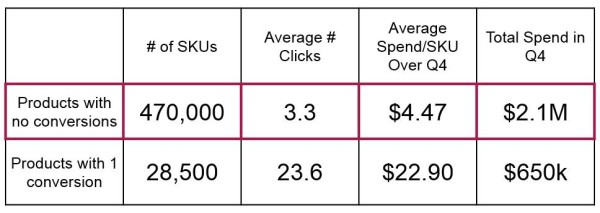Go Deep: Product Listing Ad Campaigns That Just Focus On Top Sellers Get Short Changed [Study]
Is there a long tail in PLAs? Does it pay off for retailers to advertise all of their products in their Google product listing ad (PLA) campaigns? Or should they stay focused on top sellers and high margin items? Sitting on a trove of data from large scale Google Shopping campaigns, a team at PLA […]
Is there a long tail in PLAs? Does it pay off for retailers to advertise all of their products in their Google product listing ad (PLA) campaigns? Or should they stay focused on top sellers and high margin items?
Sitting on a trove of data from large scale Google Shopping campaigns, a team at PLA management platform Adchemy decided to dig in to see if advertisers really do benefit from a long tail effect — small volume conversions across a large number of products — when they advertise their entire catalogs in PLAs.
What they found: SKUs with just one conversion in Q4 2013 accounted for 21 percent of PLA revenue.
Scott Jewett, who runs the retail consulting and content marketing efforts for Adchemy, presented the findings today at eTail West.
“Our data reveals that a significant amount of PLA revenue comes from single-conversion SKUs and that those conversions have a higher return on ad spend,” said Jewett in a statement. “Even across millions of unique SKUs, a significant chunk of them receive impressions and clicks, and those that convert just once are often more profitable than those products with multiple conversions.”
The team looked at Q4 2013 data across a sample set of customers that accounted for $6 million in spend and 1.6 million SKUs. All of the advertisers in the study advertise their entire product catalogs and use a one SKU per product target and one product target per ad group campaign structure for PLAs.
Not only did over one-fifth of all revenue come from one-time converters, the return on ad spend (ROAS) for those products was over 40 percent higher than the products that converted multiple times. Long tail SKUs also accounted for 24 percent of gross margin.
Mitigating The Risk Of Non-Converters? Are They The Real Long Tail?
Advertising an entire product catalog presents the risk of wasting a sizable amount of money on products that will never convert, or at least not at a reasonable cost-per-sale. In fact, in their research, Adchemy found that while 28,500 products had a single conversion, a whopping 470,000 (nearly half a million!) products didn’t convert at all. So it begs the question of when to cut off the tail.
Interestingly, Adchemy found that products with no conversions during the fourth quarter received just 3.3 clicks on average. In contrast, products with one conversion received 23.6 clicks.
Jewett notes a complicating factor is that bids can impact click velocity, and low velocity may just signal that a bid is too low. If a bid increase doesn’t garner more clicks quickly, though, it may be a dud.
Advertisers often focus on their top sellers and margin producers in PLAs to avoid this kind of waste from non-converting products. Yet, in doing so, Adchemy’s research shows advertisers are limiting the revenue potential from one-off conversions that come with advertising their full catalogs.
Adchemy is continuing their analysis into click velocity, and it could have big implications if, with the right controls in place, advertisers — whether managing 100 or millions of SKUs — may be able to have their cake and eat it, too.
- SKUs with one conversion in Q4 2013 had a ROAS of 7.3 percent
- SKUS with more than one conversion in Q4 2013 had a ROAS of 4.1 percent
- 24 percent of PLA gross margin is attributed to SKUs with one conversion in the quarter
Contributing authors are invited to create content for Search Engine Land and are chosen for their expertise and contribution to the search community. Our contributors work under the oversight of the editorial staff and contributions are checked for quality and relevance to our readers. The opinions they express are their own.
Related stories
New on Search Engine Land
